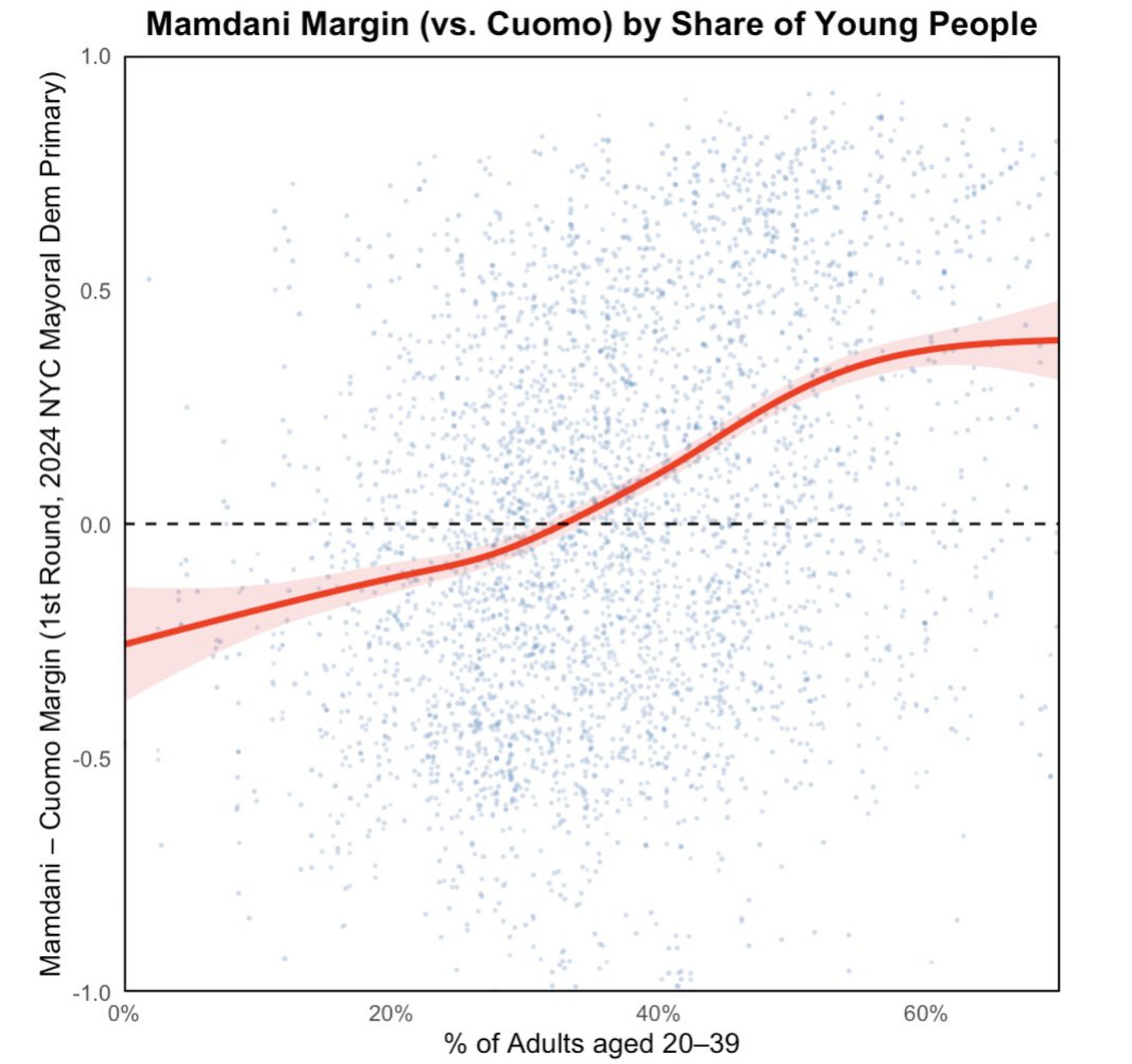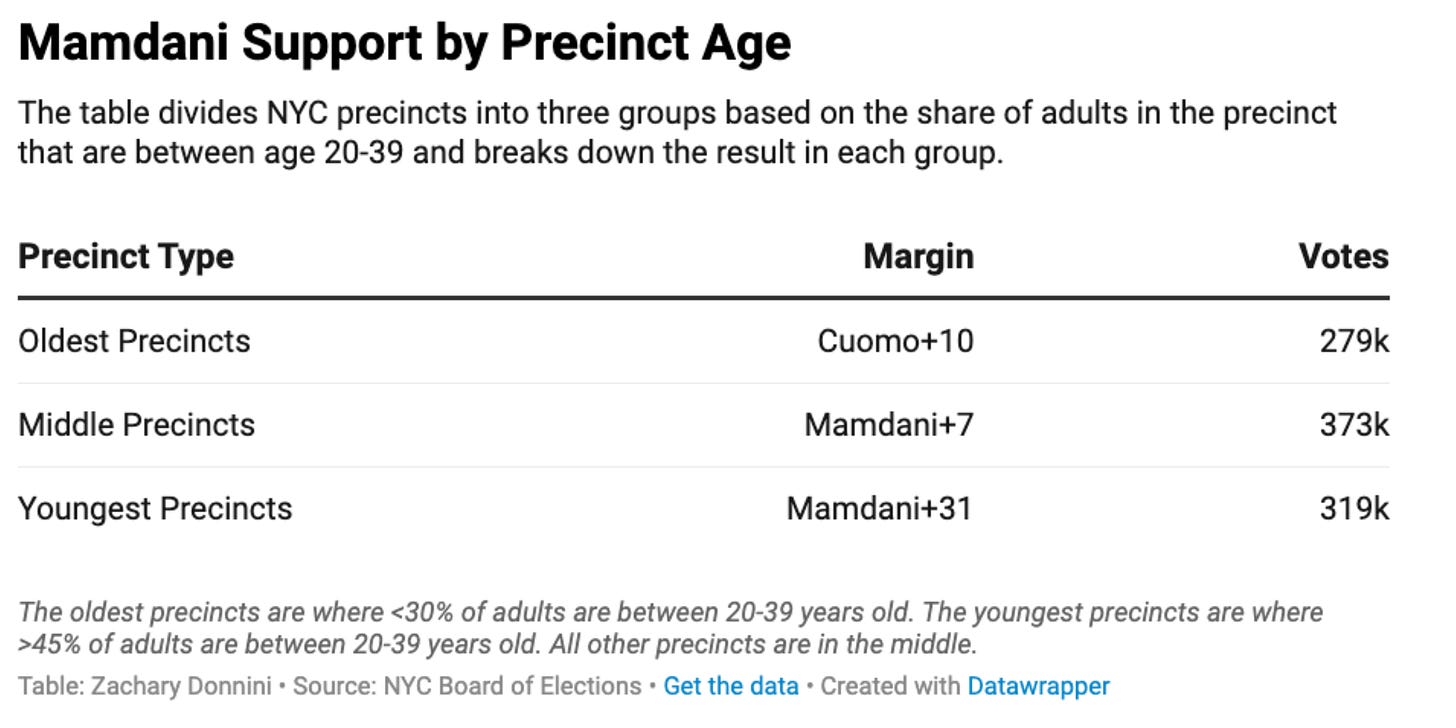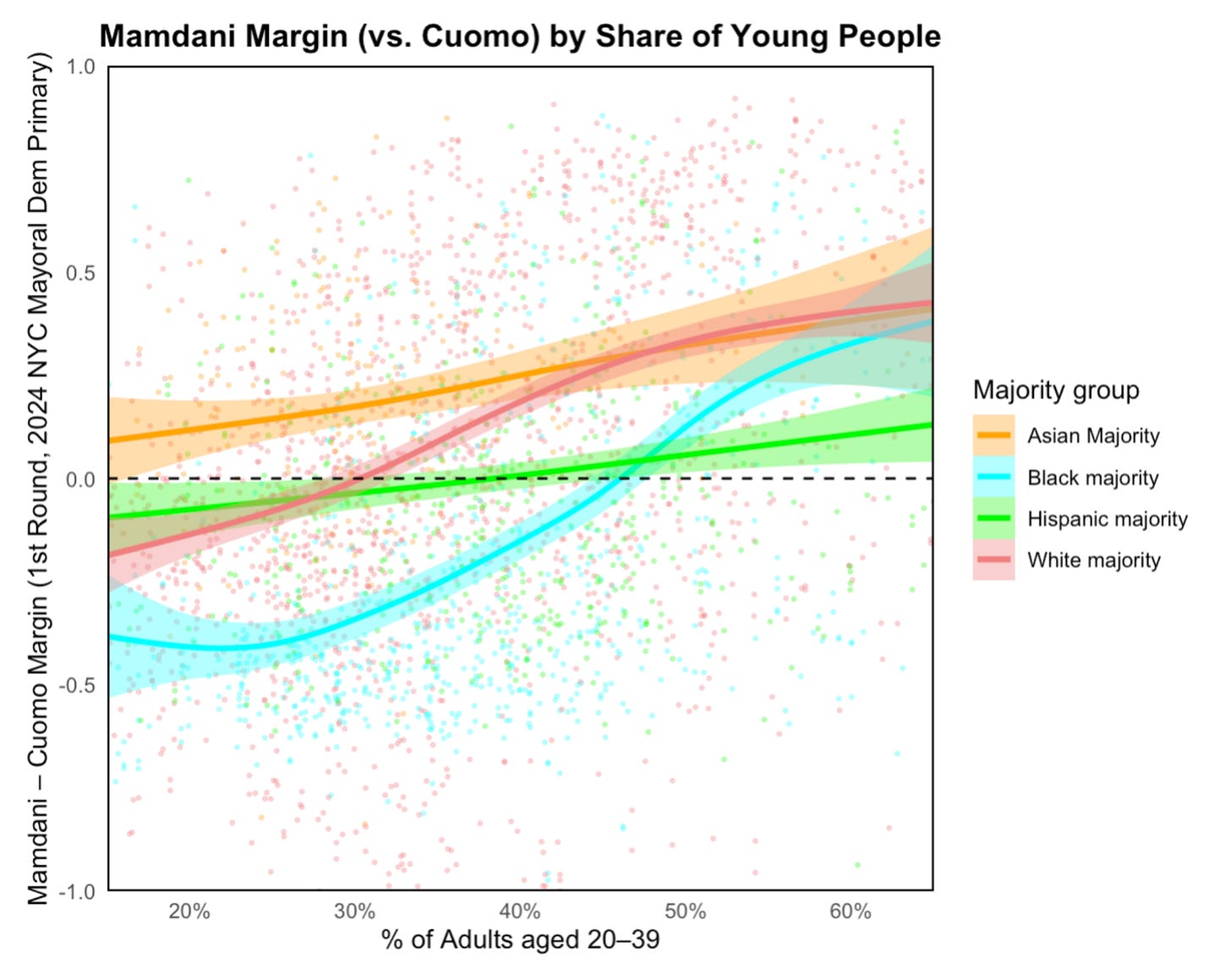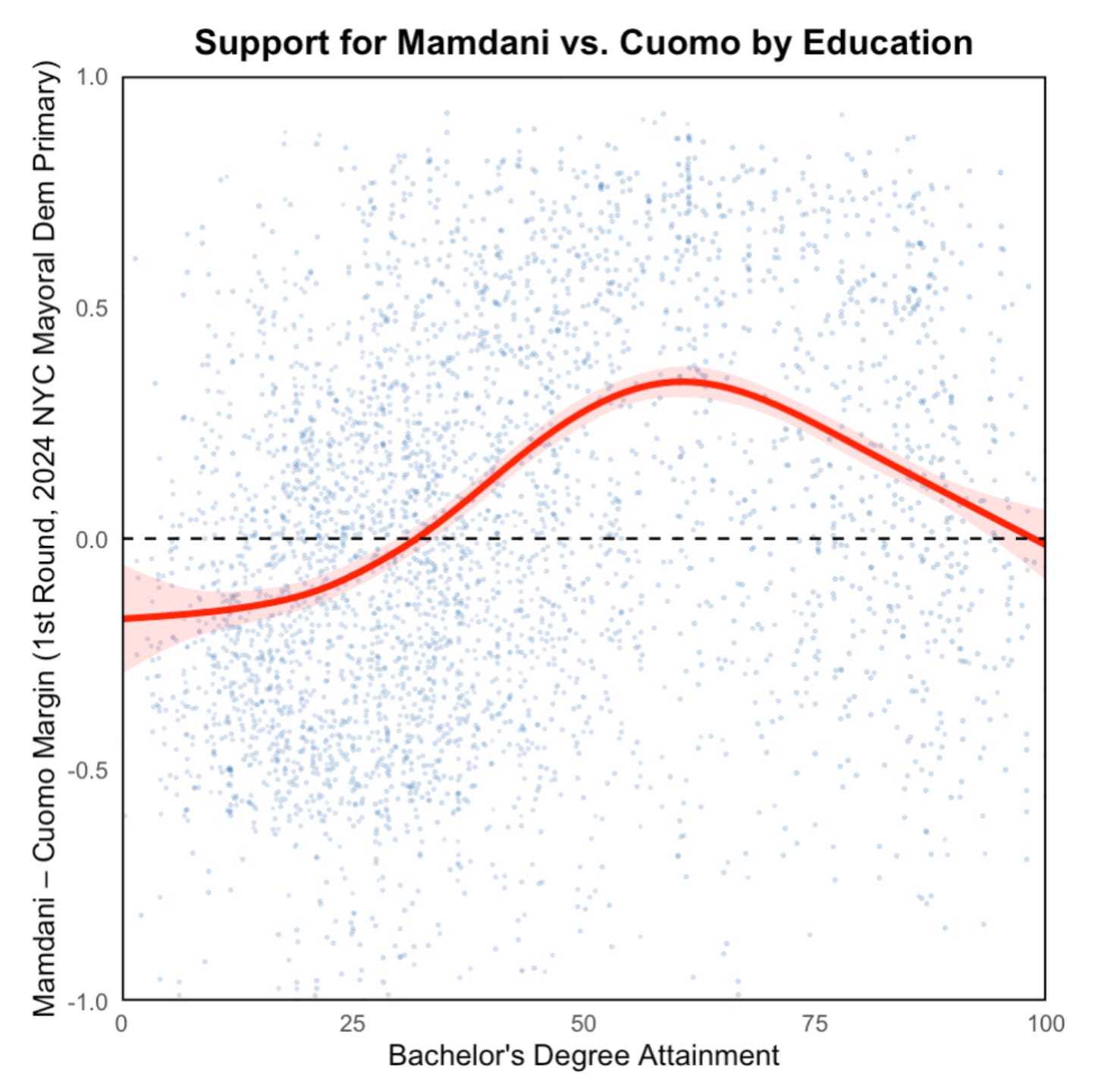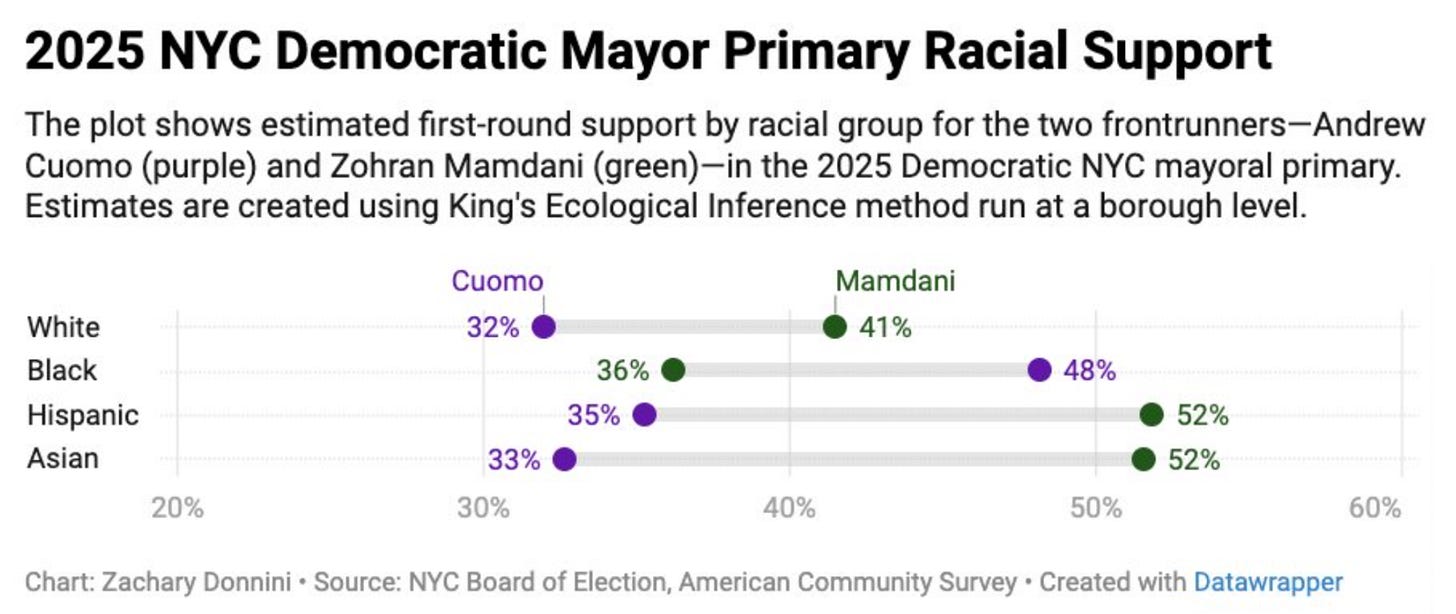How Zohran Mamdani Could Deliver the Left's Most Important Win in Years
Looking back to the primary and ahead to the general election
Zohran Mamdani is on the verge of defeating heavily favored Andrew Cuomo in the Democratic primary for New York City Mayor which is a pretty monumental election result. I want to break down how it happened by looking at how Mamdani built his winning coalition, and what this might mean for the future.
Andrew Cuomo is the former Democratic Governor of New York who was forced to resign in August 2021 following a state attorney general’s report that found he had sexually harassed multiple women, including current and former government employees, in violation of state and federal law. Zohran Mamdani is an insurgent and progressive Democratic member of the New York State Assembly, representing the 36th District in Queens since 2021. Mamdani leads 43%-36% with 96% of the 1st round vote counted according to DDHQ, and once ranked-choice voting is tabulated, Mamdani is widely expected to surpass the 50% threshold needed to win the primary. Brad Lander, who’s running a strong third with more than half of the remaining vote, has endorsed Mamdani.
The Central Role of Young Voters
First and foremost, young voters carried Mamdani to victory in the primary. In Democratic primaries, younger voters (especially millennials) consistently lean far more progressive than older generations, and that played out here. The precinct-level data makes that pretty clear.
As you can see above and below, Cuomo actually won the oldest precincts while Mamdani won the youngest precincts in a 30 point landslide.
This pattern held for both white and non-white voters. Cuomo was widely expected to dominate with non-white voters, especially Black voters, in pre-election polling. But he lost non-white voters in younger areas, which really did him in. This data is a little more noisy (you can see the thicker confident interval shading on the plot below) but you can see that this positive slope holds even after stratifying by race, and is especially notable in Black majority areas.
Upper-Middle-Class Voters Continue to Anchor Urban Progressive Blocs
Second, upper-middle-class voters were the engine behind Mamdani’s win. Cuomo performed best in the city’s poor and working-class areas—though those are relatively limited outside the Bronx and Orthodox Jewish neighborhoods. His second-best showing came in the ultra-educated, high-income parts of the city, which tracks: the NYC elite mobilized against a democratic socialist.
I posted a much worse version of this chart on Twitter, and it got tons of love because the underlying pattern is pretty interesting and so much hate because it was *terrible* data viz—the massive mob of blue points was apparently very distracting to people, who would have guessed. I like keeping the points in the plot to show that a Cuomo+10 average in low-education areas actually reflects a mix of tons of Mamdani+20 precincts and tons of Cuomo+50 precincts. But if this keeps causing confusion, I might have to drop them entirely. For now, I’m hoping that making the points smaller and lighter helps shift the focus to the red line—and especially the SE ribbon around it.
Expansion Beyond Traditional Progressive Coalition
As I noted above, it’s totally expected that young and upper-class voters of all races were the core of Mamdani’s progressive coalition—that’s standard in Democratic primaries. The big new story here is how well Mamdani did with Hispanic and Asian voters. Cuomo was polling strong with both groups and was widely expected to win them on Tuesday. But that didn’t happen. He lost Asian voters pretty much across the board, and got crushed with more assimilated, younger, higher-education Hispanic voters (especially in areas where Hispanics weren’t the majority, like a lot of Manhattan and Brooklyn).
What’s notable is that both groups swung hard toward Trump in 2024. I think that’s connected for two reasons: (1) there's deep frustration with the Democratic establishment, and a lot of voters aren’t as ideologically consistent as people think—voting for both Trump and Mamdani can be consistent as anti-establishment choices. And (2) many of the truly moderate or conservative Hispanic and Asian voters have already left the Democratic Party, so they’re not there anymore to support moderates like Cuomo. That’s not the case with Black voters. Conservative and moderate Black Democrats are still a major force in NYC primaries, and they anchored Cuomo’s support.
Mamdani General Election Chances
Mamdani is widely expected to win the Democratic primary next Tuesday when RCV is computed and I consider him a heavy, heavy favorite to win the general election. Sometimes I feel guilty because in D&D I just tell people that prediction markets are roughly right, but I think Mamdani has a significantly better than 74% chance to become the next mayor of New York City.
The current field includes Andrew Cuomo running on an alternative ballot line, incumbent mayor Eric Adams as an independent, Republican nominee Curtis Sliwa, and a genuinely strong independent bid from attorney Jim Walden. In a five-way race like this, with the opposition split, Mamdani will win easily. Even in a three- or four-way contest, he’d be heavily favored. It’s possible that a couple of Cuomo, Sliwa, and Walden drop out, but unless the field clears to a two-way race, he’s in a strong position.
If people actually wanted to coordinate to stop Mamdani, it wouldn’t be that hard. Being mayor of Manhattan would be like being mayor of San Francisco or Boston, but NYC as a whole isn’t the most Democratic city in the country. It went from Biden +54 to Harris +39—so a candidate with Republican backing would start with a solid 25–30% base and only need to win about a third of Harris voters to beat Mamdani.
If the field cleared for him, Jim Walden would probably be favored in a 1v1 matchup against Mamdani. But that level of coordination seems pretty unlikely right now. (Others also agree this is by far the clearest route to beat Mamdani but is incredibly unlikely to happen). Adams himself could have a shot at beating Mamdani if he managed to clear Cuomo, Sliwa, and Walden from the field—which is a more realistic path. But even then, I think Mamdani would still be favored. Adams would be running with a pretty unusual coalition: Trump voters and Black voters. That’s an interesting proposition, but I think he’d have a harder time than someone like Walden, especially with the technocratic Kathryn Garcia-type voters who are likely to be turned off by Adams because of his corruption issues and relatively friendly relationship with Trump.
Throwing Some Water on the Fire
As I said in the title, this is definitely set to be the left's biggest win since AOC defeated Joe Crowley, and potentially even bigger. But let me play devil’s advocate and throw some cold water on the excitement.
It's nothing new for the left to prove they can win Democratic municipal primaries in the most lefty cities in the country. Sure, this was against a massive disadvantage in name recognition and fundraising, and NYC is a much bigger fish to fry that gets far more national media attention. But, Brandon Johnson won in Chicago just two years ago and now sits at a 6% approval rating as mayor. Progressive DA George Gascón won in Los Angeles in 2020, only to get absolutely demolished by an independent in 2024, running a staggering 53 points behind fellow Democrat Kamala Harris in the same county. The Bay Area tells a similar story. Progressive prosecutors Chesa Boudin and Pamela Price both became district attorneys, but their tenures were such disasters they couldn't even finish their terms before getting recalled. Then Oakland turned around and elected progressive Barbara Lee as mayor in 2025.
This is shaping up to be the left's biggest electoral win in forever, but it could all be for nothing (and potentially really damaging to the gaining momentum of the movement) if Mamdani can't break the recent pattern of his progressive predecessors having spectacularly unsuccessful tenures actually governing.


